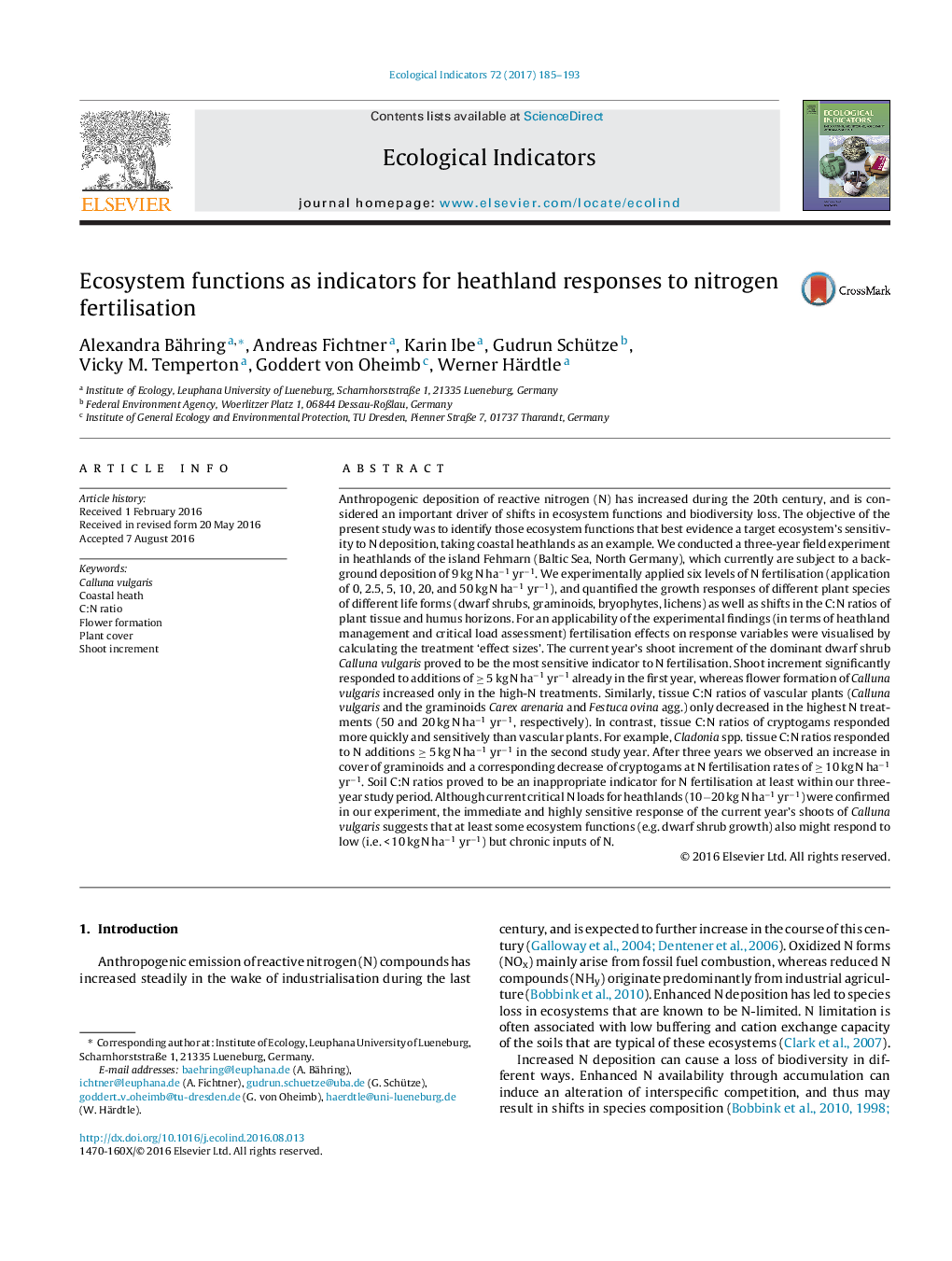| کد مقاله | کد نشریه | سال انتشار | مقاله انگلیسی | نسخه تمام متن |
|---|---|---|---|---|
| 6292732 | 1617130 | 2017 | 9 صفحه PDF | دانلود رایگان |
عنوان انگلیسی مقاله ISI
Ecosystem functions as indicators for heathland responses to nitrogen fertilisation
ترجمه فارسی عنوان
اکوسیستم به عنوان شاخص هایی برای پاسخ های هیتلند به کود نیتروژن عمل می کند
دانلود مقاله + سفارش ترجمه
دانلود مقاله ISI انگلیسی
رایگان برای ایرانیان
موضوعات مرتبط
علوم زیستی و بیوفناوری
علوم کشاورزی و بیولوژیک
بوم شناسی، تکامل، رفتار و سامانه شناسی
چکیده انگلیسی
Anthropogenic deposition of reactive nitrogen (N) has increased during the 20th century, and is considered an important driver of shifts in ecosystem functions and biodiversity loss. The objective of the present study was to identify those ecosystem functions that best evidence a target ecosystem's sensitivity to N deposition, taking coastal heathlands as an example. We conducted a three-year field experiment in heathlands of the island Fehmarn (Baltic Sea, North Germany), which currently are subject to a background deposition of 9 kg N haâ1 yrâ1. We experimentally applied six levels of N fertilisation (application of 0, 2.5, 5, 10, 20, and 50 kg N haâ1 yrâ1), and quantified the growth responses of different plant species of different life forms (dwarf shrubs, graminoids, bryophytes, lichens) as well as shifts in the C:N ratios of plant tissue and humus horizons. For an applicability of the experimental findings (in terms of heathland management and critical load assessment) fertilisation effects on response variables were visualised by calculating the treatment 'effect sizes'. The current year's shoot increment of the dominant dwarf shrub Calluna vulgaris proved to be the most sensitive indicator to N fertilisation. Shoot increment significantly responded to additions of ⥠5 kg N haâ1 yrâ1 already in the first year, whereas flower formation of Calluna vulgaris increased only in the high-N treatments. Similarly, tissue C:N ratios of vascular plants (Calluna vulgaris and the graminoids Carex arenaria and Festuca ovina agg.) only decreased in the highest N treatments (50 and 20 kg N haâ1 yrâ1, respectively). In contrast, tissue C:N ratios of cryptogams responded more quickly and sensitively than vascular plants. For example, Cladonia spp. tissue C:N ratios responded to N additions ⥠5 kg N haâ1 yrâ1 in the second study year. After three years we observed an increase in cover of graminoids and a corresponding decrease of cryptogams at N fertilisation rates of ⥠10 kg N haâ1 yrâ1. Soil C:N ratios proved to be an inappropriate indicator for N fertilisation at least within our three-year study period. Although current critical N loads for heathlands (10â20 kg N haâ1 yrâ1) were confirmed in our experiment, the immediate and highly sensitive response of the current year's shoots of Calluna vulgaris suggests that at least some ecosystem functions (e.g. dwarf shrub growth) also might respond to low (i.e. < 10 kg N haâ1 yrâ1) but chronic inputs of N.
ناشر
Database: Elsevier - ScienceDirect (ساینس دایرکت)
Journal: Ecological Indicators - Volume 72, January 2017, Pages 185-193
Journal: Ecological Indicators - Volume 72, January 2017, Pages 185-193
نویسندگان
Alexandra Bähring, Andreas Fichtner, Karin Ibe, Gudrun Schütze, Vicky M. Temperton, Goddert von Oheimb, Werner Härdtle,
